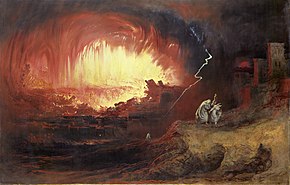Catabole: Difference between revisions
mNo edit summary |
mNo edit summary |
||
| Line 3: | Line 3: | ||
{{Infobox event | {{Infobox event | ||
| title = Catabole | | title = Catabole | ||
| image = John Martin - Sodom and Gomorrah.jpg | | image = [[File:John Martin - Sodom and Gomorrah.jpg|290px]] | ||
| caption = ''The Catabolic Destruction of X'' (1849) by [[Archibald Glover]], {{wp|oil painting|oil on canvas}} | | caption = ''The Catabolic Destruction of X'' (1849) by [[Archibald Glover]], {{wp|oil painting|oil on canvas}} | ||
| date = {{Start date and age|1348|9|13|df=t}} | | date = {{Start date and age|1348|9|13|df=t}} | ||
Revision as of 20:00, 3 July 2024
This article is incomplete because it is pending further input from participants, or it is a work-in-progress by one author. Please comment on this article's talk page to share your input, comments and questions. Note: To contribute to this article, you may need to seek help from the author(s) of this page. |
 The Catabolic Destruction of X (1849) by Archibald Glover, oil on canvas | |
| Date | 13 September 1348 |
|---|---|
| Time | Unknown, likely 14:15–14:45 |
| Location | 17 km (10 mi) off the coastline of X, X, X (X Sea) |
| Cause | Impact event of a small asteroid |
| Outcome | Widespread cataclysmic damage in Calesia, eastern Abaria and northern Hylasia, reduced global temperatures leading to famine (Catabolic Crisis) |
| Deaths | 2.65–3.5 million from direct impact effects; hundreds of millions due to post-impact global famine and epidemic diseases |
The Catabole, also referred to as the Catabolic Event or the Great Calamity, was the impact of a superbolide in the X Sea in the early afternoon of 13 September 1348. The presumably 350–370 m (1,210 ft) diameter, 61 million tonnes heavy near-Teleon C-type asteroid with a carbonaceous crondite-like composition, called the Catabolic impactor, struck Teleon approximately 17.4 km (10.8 mi) off the shoreline of X in X at a shallow atmospheric entry angle of 21.1 degrees and a speed relative to Teleon of 28.6 km per second (17.8 mi per second). The impact had profound effects on the course of world history.
The object impacted the sedimentary rock of the sea floor with a kinetic energy equivalent of about 1,150 megatons of TNT and instantaneously formed an impact crater 4.9 km (3.0 mi) wide and 850 m (2,789 ft) deep. The resulting emission of thermal radiation, shockwaves, seismic activity, and expulsion of megatsunamis over 80 m (262 ft) tall led to the widespread devastation of communities along the surrounding coasts of the X Sea and the broader X, killing approximately 2.65–3.5 million people in one of the deadliest single natural disasters in recorded history; numerous major cities such as X and X were entirely annihilated. It was the worst natural disaster in Calesian and Hylasian history, the worst natural disaster in a millenium, and the largest impact event ever witnessed by humankind.
Sulfur-rich gypsum from the seabed was vaporized in large quantities and injected into the atmosphere as aerosols, triggering significant climate change in an impact winter. As a result, extreme weather and harvest failures led to widespread famine, economic distress, the outbreak of epidemic diseases such as cholera, and ultimately major religious, political, and social upheaval around the world. It is estimated that about 30% to 60% of Calesia's population, and about 35% of the entire world population, were wiped out during the 1348–1353 Catabolic Crisis in the aftermath.
